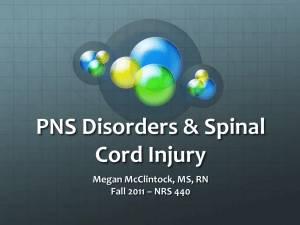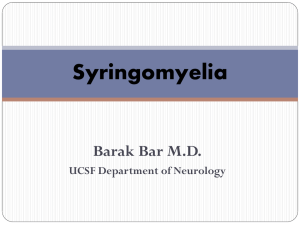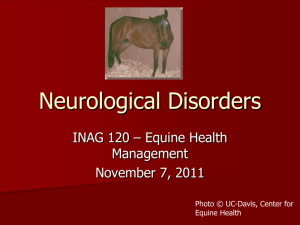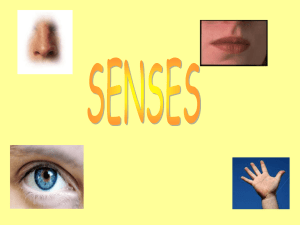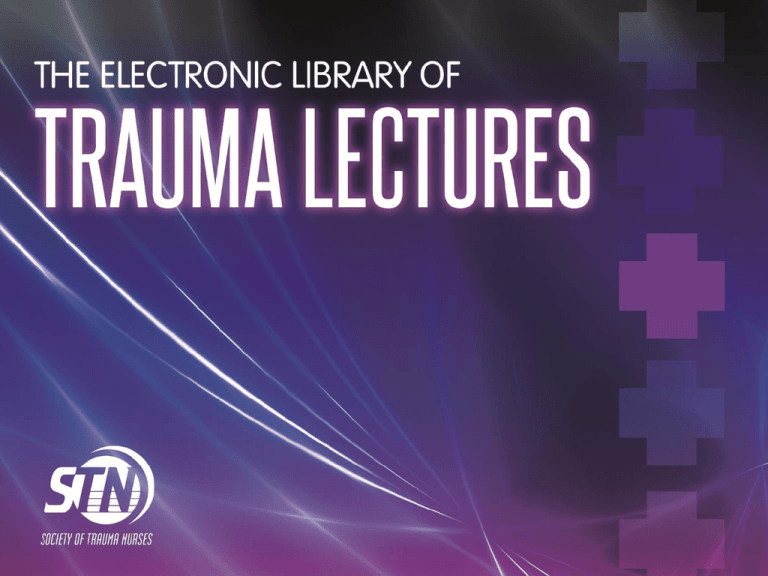
Spinal Column and
Spinal Cord Injuries
Objectives
At the conclusion of this presentation
the participant will be able to:
• Identify the components of the spine
• Assess for spine and spinal cord injury
• Discuss the initial management of the
spinal cord injured patient
• Evaluate the long term needs of the spinal
cord injured patient
• Describe effects of spinal cord injury on
the rest of the body
Epidemiology
• Approx 12,000 new cases per year
• Average age 40.7 years
• 80.7% male
• Increased incidence among African
Americans (27%) and Asians (2%)
• Most common causes - MVC (41%),
Falls, Violence
Anatomy and Physiology
•
•
•
•
•
Vertebrae
Discs
Ligaments
Spinal cord
Vessels
Vertebral Column
Thoracic vertebra
Wikimedia.com
Vertebra
Cervical Vertebrae
Spinal Cord
Spinal cord
Nerve roots
Anatomy and Physiology
• Gray Matter
•
•
•
Anterior - motor
Inter-mediolateral –
sympathetic/
parasympathetic
Posterior - sensory
• White Matter
•
•
•
Anterior -motor
Lateral – 8 tracts
Posterior -position
Spinal Cord
Anatomy and Physiology
• Upper motor neuron (UMN)
• Modulated by cerebrum, cerebellum,
basal ganglia, reticular neurons
• Injury = paralysis, hypertonicity,
hyperreflexia
• Lower motor neuron (LMN)
• Originated in CNS
• Injury = flaccidity, hyporeflexia,
fasciculations
Anatomy and Physiology
http://pt851.wikidot.com/spinal-cord-injury-cell-biology
Anatomy and Physiology
Mechanisms of Injury
McQuillan, K., Von Rueden, K.,
Hartsock, R., Flynn, M., & Whalen,
E. (eds.). (2002). Trauma Nursing:
From Resuscitation Through
Rehabilitation. Philadelphia: W. B.
Saunders Company. Reprinted
with permission.
Initial Management
Pre-hospital
Resuscitation
Assessment
Cervical plexus C3-4 Diaphragm
Cervical vertebrae (7)
C5 Deltoid and biceps
C6 W rist extensors
C8 Hands
T2-T7 Internal and External
Intercostals
Thoracic vertebrae (12)
T8-12 Abdom inals
L2 Hip flexor
L3 Knee extension
Lum bar vertebrae (5)
L4 Ankle dorsiflexion
Cauda
Equinas
L5 Great toe extension
S1 Ankle plantar flexion
S2-5 Bow el, bladder, and
sexual function
Sacral vertebrae (5 fused)
Coccyx
(4 fused)
Dermatomes
Sensorimotor Assessment
Lateral corticospinal tract
Lateral spinothalamic tract
Dorsal column
Reflex Assessment
• Test for sensory/motor
sparing
• Major deep tendon reflexes
(DTR) assessed
• Biceps (C5)
• Brachioradialis (C5-6)
• Triceps (C7-8)
• Quadriceps (knee-jerk)
(L3-4)
• Achilles (S1-2)
• Scoring 0 to ++++
++
++
++
++
++
++
++
++
++
++
Superficial Reflex Assessment
Abdominal - umbilicus pulls toward
stimulus
Cremasteric - scrotum pulls up with
stoking inner thigh
Bulbocavernosus - anal sphincter
contraction with stimulus
Superficial anal – anal sphincter
contraction with stroking peri-anal area
Priapism – results with tugging on
catheter
Spinal Cord Injury
•
Primary
• From the time of initial mechanism of injury
•
Secondary
• Any incidence of hypotension or hypoxia can
result in further injury to the spinal cord
Spinal Cord Injury
• ASIA Impairment scale
•
•
•
•
•
Complete (A) – lack of motor/sensory function in
sacral roots (S4-5)
Incomplete (B) – sensory preservation, motor
loss below injury including S4-5
Incomplete (C) – motor preservation below injury,
more than ½ muscle groups motor strength <3
Incomplete (D) - motor preservation below injury,
at least 50% muscle groups motor strength >3
Normal (E) – all motor/sensory function present
Cord Syndromes
• Central Cord
• Typically fall with
hyperextension
• Elderly
• Presents with weak
upper extremities,
variable bowel and
bladder dysfunction,
disproportionately
functional lower
extremities
Cord Syndromes
• Anterior Cord
• Primarily a
hyperflexion
mechanism
• Anterior segment of
spinal cord controls
motor function
below the injury
Cord Syndromes
• Brown-Sequard
• Hemisection of
the cord usually
from penetrating
injury
• Loss motor on
side of injury
• Loss of
sensation on the
opposite side
Image found on Wikimedia.org
Cord Syndromes
• Conus Medullaris
•
•
•
S4-5 exit at L1; may have L1
fracture
Areflexic bowel and bladder,
flaccid anal sphincter
Variable lower extremity loss
• Cauda Equina
•
•
Lumbar sacral nerve roots, with
or without fracture
Variable loss; areflexia; radicular
pain
Complete Cord Injury
• Quadriplegia
(Tetraplegia)
•
•
•
Loss of function below the
level of injury
Includes sacral roots
(bowel and bladder)
C1-T1
• Paraplegia
•
•
Loss of function below the
level of injury
Below T1
Diagnostics
•
•
•
Plain films
• Lateral, A/P, odontoid; C-T-L spines
• May be used for rapid identification of
gross deformity
CT Scan
• Comprehensive, cervical through
sacral
• Demonstrates degree of compression
and cord canal impingement
MRI Scan
• Demonstrates ligamentous, spinal
cord injury
Diagnostics
• Clearing the Cervical Spine
•
•
•
•
Awake, alert, and oriented
NO distracting injuries
NO drugs or alcohol that alter
experience
NO pain or tenderness
• Clearing spine with films, CT,
MRI
•
•
•
Complaints of neck pain
Neurologic deficit
Altered level of consciousness,
ventilator
Fractures-Dislocations
•
•
•
Atlanto-occipital dissociation
• Complete injury; death
Atlanto-axial dislocation
• Complete injury; death
Jumped, Jump-locked facets
• Require reduction; may
impinge on cord; unstable
due to ligamentous injury
Fractures-Dislocations
• Facet fractures
• High incidence of
cord injury in
cervical spine
• Odontoid (dens)
fractures
• Rarely cord injury
Fractures-Dislocations
Compression
fractures
Chance
fracture
Burst
fracture
SCIWORA
• Spinal Cord Injury without
Radiographic Abnormality
• Most frequently children
• Dislocation occurs with spontaneous
relocation
• Cord injury evident
• Radiographs negative
Management
• Airway
• C1-4 injuries require definitive airway
• Injuries below C4 may also require airway
due to
• Work of breathing
• Weak thoracic musculature
• Breathing
• Adequacy of respirations
•
•
•
•
SpO2
Tidal volume
Effort
Pattern
Management
• Circulation
• Neurogenic shock
•
•
•
•
•
Injuries above T6
Hypotension
Bradycardia –treat symptomatic only
Warm and dry
Poikilothermic – keep warm
• Fluid resuscitation
• Identify and control any source of bleeding
• Supplement with vasopressors
Neurogenic Shock
Injury to T6 and above
Loss of sympathetic innervation
Bradycardia
Increase in venous capacitance
Decrease in venous return
Hypotension
Decreased cardiac output
Decreased tissue perfusion
Management
• Urine output
• Urinary retention
• Atonic bladder
• Foley
• Initially avoid
intermittent
catheterization
• High urine
output from
resuscitation
fluids
Management
• Deficit
• Spinal shock
• Flaccid paralysis
• Absence of cutaneous and/or
proprioceptive sensation
• Loss of autonomic function
• Cessation of all reflex activity below the
site of injury
• Identify level of injury
Management
• Pain
•
•
•
•
Frequent physical and verbal
contact
Explain all procedures to
patient
Patient-family contact as soon
as possible
Appropriate short-acting pain
medication and sedatives
• Foster trust
Management
• Communication
• Blink board
• Adapted call bell system
• Avoid clicking, provide a
better option
• Speech and occupational
therapy
• Prism glasses
• Setting limits/boundaries
for behavior
Management
• Special Treatment
•
Hypothermia
•
•
•
•
•
Recommends 33oC intravascular cooling
Rapid application, Monitor closely
Anecdotal papers
No peer reviewed/ class I clinical research
studies to substantiate
High dose methylprednisolone
• No longer considered standard of care
Management
• Pharmacologic agents
• Lazaroids (21-aminosteroids)
• Opiate antagonists (Naloxone)
• EAA receptor antagonists
• Calcium channel blocker
• Antioxidants and free radical scavengers
• Arachidonic acid inhibitors
Management
• Reduction
•
•
Cervical traction
• Halo
• Gardner-Wells tongs
Surgical
• Stabilization
•
•
Cervical collar – convert to
padded collar as soon as
possible
CTO or TLSO for low
cervical, thoracic, lumbar
injuries
McQuillan, K., Von Rueden, K., Hartsock, R., Flynn, M., &
Whalen, E. (eds.). (2002). Trauma Nursing: From
Resuscitation Through Rehabilitation. Philadelphia: W. B.
Saunders Company. Reprinted with permission.
Management
• Rotational bed therapy
• Maintain alignment and traction
• Prevent respiratory complications of
immobility
Management
• Surgical
• Determined by
• Degree of deficit, location of injury, instability,
cord impingement
• Anterior vs. posterior decompression/ both
• Emergent
• Reserved for neurologic deterioration when
evidence of cord compression is present
• SSEP –during procedure to monitor
changes
• Limited to ascending sensory tracts esp..
dorsal columns
Complication Prevention
• Respiratory
• Complications of immobility
• Atelectasis, Pneumonia
• Pulmonary embolism
• Respiratory insufficiency/ failure
• Level of injury affects phrenic nerve,
intercostals
• Increased work of breathing, fatigue
• Rate and pattern are altered (accessory
muscle use)
• Monitor breath sounds
Respiratory
Ventilation
Early intubation to prevent hypoxia and fatigue
C1-4 injuries require tracheostomy and home ventilation
training
Quad cough training
Communication tools
Bronchoscopy
Respiratory
• Pulmonary management
•
Weaning parameters
•
Monitor SpO2 and ABGs
•
Routine CXR
•
Aggressive pulmonary toilet
– Postural drainage (PD)
– Chest physiotherapy (CPT)
– Kinetic bed therapy
•
Suctioning
Respiratory
• Non-ventilated patients
• Pulmonary function tests
• Incentive Spirometry
• Non-invasive ventilation
(CPAP, BiPAP)
• Abdominal binder
• Early OOB/ mobilization
Complication Prevention
• Cardiovascular
• Neurogenic shock
• IV fluids –includes
vasopressors
• Atropine or pacing
ONLY when
bradycardia
symptomatic
Cardiovascular
• Orthostatic hypotension
• Decreased BP, possibly increased heart
rate, dizziness or lightheadedness,
blurred vision, loss of consciousness
• Provide physical support with hose,
abdominal binder; salt tablets; Florinef;
sympathomimetics
• Slowly raise the head of the bed for
mobilization
• Turn slowly
• Prone to vasovagal response
Cardiovascular
• Poikilothermia
• Inability to shiver/sweat and
adjust body temperature
• Keep patient warm
• Warm the environment
• Monitor skin to prevent
burns or frostbite from
exposure
• Insensate skin
Complication Prevention
• Gastrointestinal
•
•
•
•
•
•
Ileus
Gastric/ intestinal ulcers
Pancreas dysfunction
Nutritional deficiencies
Constipation/ impaction
Cholecystitis
Gastrointestinal
• Abdominal distention
•
•
•
•
Nasogatric tube to decompress stomach
Monitor bowel sounds
Monitor N/G output for bleeding
Gastric prophylaxis• Histamine blockers, proton-pump inhibitors,
antacids
• Bowel routine
• Stool softeners, suppositories; high fiber diet
• Digital stimulation, fluids, mobilization
Gastrointestinal
• Nutrition
• Early enteral nutrition
• PO or tube feeding if ventilated
• Transpyloric tube if slow gastric
emptying
• Hypermetabolic rate
• Feed as with any critically
injured patient
Complication Prevention
• Venous thromboembolism
• Slightly higher risk the first 2-3 months post
injury
• Duplex ultrasonography evaluation
• Prevention (x 3months)
• LMWH
• Apply sequential compression devices
• Vena cava filter (in patients who cannot be anticoagulated or have failed anti-coagulation)
• Monitor for signs and symptoms
• Early mobilization, hydration
Complication Prevention
Reflexive bladder – involuntary contraction
• Fluid restriction transition to
straight cath
• Condom catheters, SPT
• Palpate for fullness (approx
5-600ml/4-6hr)
Urinary
• Areflexive bladder
• Valsalva or crede
• Prone to incontinence/ skin issues
• Condom catheters, incontinence pads,
conduit
• DSD
• Results in elevated voiding pressures
• Annual urodynamic evaluation
• Pharmacologic management, Surgical
intervention (sphincterotomy)
Urinary Tract Infection
• Signs and symptoms
• Fever, spontaneous voiding
between catheterizations,
Autonomic Dysreflexia, hematuria,
cloudy- foul-smelling urine, vague
abdominal discomfort, pyuria
• Prevention
• Remove indwelling catheter as
soon as clinically possible,
intermittent cath, hydration
Urinary
Renal calculi
• Chronic bacteriuria and sediment, longterm indwelling catheters, urinary stasis,
chronic calcium loss
• Signs and symptoms – persistent UTI,
hematuria, unexplained Autonomic
Dysreflexia
• KUB x-ray, IVP with cystogram, passage
of stone
• Interventions - increased fluid intake,
dietary modifications, lithotripsy
Complication Prevention
Skin breakdown
• Pressure, insensate, dampness
• PREVENTION – frequent turning,
specialty beds, remove backboard asap;
proper fitting braces
• Nutrition, mobilization, cushions,
massage
• Early wound care specialist
• Surgery if deep
• Can cause delays in stabilization,
rehabilitation
Complication Prevention
Musculoskeletal
• Spasticity – flexor, extensor, alternating
•
•
•
Reduce venous pooling, stabilize thorax, aids in
dressing and stand-pivot transfer
Chronic pain, contractures, heterotrophic ossification,
skin breakdown
ROM, positioning, weight-bearing, splinting,
pharmacologic management, surgery- neural severing
(permanent)
Musculoskeletal
Heterotrophic ossification
• Ectopic bone within
connective tissue
• Below spinal lesion
• More often complete
injuries with spasticity
• Redness, swelling, warmth,
pain, decreased ROM,
fever, positive bone scan
Musculoskeletal
Contractures
•
•
•
Imbalance of muscle
innervation
High level cord injury, skin
breakdown, concomitant
head injury, spasticity, HO,
fractures
PREVENTION – aggressive
ROM, mobilization, PT/OT,
splinting, positioning, serial
casting, anti-spasmodics
Complication Prevention
Neurologic - Post traumatic Syingomyelia
A fluid filled cavity
which develops within
the spinal cord
Surgical
decompression
Most common
symptom is pain
Serial monitoring
via MRI
Complication Prevention
Autonomic dysreflexia
• An uncontrolled, massive sympathetic
reflex response to noxious stimuli, below
the level of the lesion
• Precipitating factors
•
•
•
•
•
•
Full bladder
Distended bowel
Skin irritation, ingrown toenail
UTI
Uterine spasms, penile stimulation
Tight clothing, wrinkled sheets
Autonomic Dysreflexia
Autonomic Dysreflexia
• Sit patient upright to produce orthostatic
hypotension
• Monitor BP every 5 minutes
• Monitor neurologic status (GCS)
• Eliminate the offending stimulus
•
Empty bladder, bowel; identify skin lesion
• Administer anti-hypertensives if the above
fails
• Education –family and patient
Psychologic
Pain/Depression
• Nocioceptive – noxious
stimuli to normally
innervated parts
• Neurogenic – nerve tissue
injury in CNS or PNS
• Evaluate for depression
associated with pain
• Counseling, ROM,
pharmacologic treatment,
TENS
Sexuality
Male sexuality
•
•
•
•
Erection – parasympathetic
Requires intact sacral reflexes, shortlived
• Technical aides, pharmacology,
prosthesis
Ejaculation – sympathetic
• Intrathecal injection,
electroejaculation, vibroejaculation
Fertility – decreased sperm motility
and quality
• Serial ejaculation, in vitro
fertilization
Sexuality
Female
• Lack innervation to pelvic floor
• Maintain reflex lubrication/
congestion
• Loss psychogenic/ fantasy
response
• Fertility normal
• Pregnancy – loss of sensation,
increased BP, may precipitate AD
• Decreased respiratory excursion
• Alter GI/GU management
Rehabilitation
•
Mobility
•
•
•
•
•
Tendon transfer
Functional electrical
stimulation
Lower level of injury,
more functional
Bowel and Bladder
Management
Prevention of
complications
Summary
• Spinal cord injury occurrence is
decreased with safety equipment use
• Prevent secondary injury to result in
optimal neurologic recovery
• Spinal column fractures can occur
without long term effects
• Spinal cord injury requires diligence in
complication prevention






